Attaching the main
halyard and the jib sheet
by Ton Jaspers (W5011)
Main Halyard
Many sailors have thought long
and hard about a simple system to attach the halyard to the mainsail. Almost
all systems have some disadvantage. Before we go through possible systems,
letís see what the requirements are:
-
has to be reliable
-
has to be strong
-
has to be easy to fasten and release,
even with wet, cold hands
-
must allow the main to be hoisted
to the upper black band. With many boats that is almost against the halyard
sheave.
Eye splice and shackle
Unless the mast has enough
extra height and the sheave is well above the upper black band, most solutions
with an eye splice and pin shackle (or carbine hook) are unusable because
they do not allow the main to be hoisted right up to the upper black band.
With a stainless steel wire halyard there are unfortunately not many other
options available. Often there is no problem because stainless steel wire
allows a very small eye and by using the smallest possible shackle, the
problem is usually avoided. Older masts donít have this problem since they
were couple of inches longer than the modern masts.
Dyneema rope halyards
Nowadays, the wire main halyard
is often replaced by Dyneema lines. Dyneema is just as strong but lighter
and easier to handle. Dyneema does stretch a little more than wire but
the extra stretch is acceptable in a main halyard. With a rope halyard,
the question becomes what knot to use in attaching the halyard to the head
of the mainsail.
-
The Bowline Due to the
large forces the bowline is often hard to untie, especially with wet and
cold hands. Though better than a splice and shackle, this knot will still
sometimes prevent the mainsail from being hoisted right to the upper black
band. The bowline also reduces the rope strength.
-
The Clove Hitch and other hitches
The clove hitch
has a tendency to slip when loaded heavily but it does allow the sail to
be hoisted against the sheave. A variation on the clove hitch, the constrictor
hitch, does not have this disadvantage but it is virtually impossible to
untie it. Other hitches, like the tautline
hitch or the anchor hitch are stronger than the bowline but harder
to make and often very difficult to untie.
-
The "ideal knot" It seems
as if knots do not fulfil the criteria above, yet there is an ideal knot
that meets all criteria. For this knot to work, a plastic stopper at the
bitter end of the halyard is needed. The stopper
has to be large enough to prevent it from slipping through the hole in
the mainsail head board so that the knot will not come undone accidentally.
The diagram below shows how the halyard is fixed to the top of the main
sail.
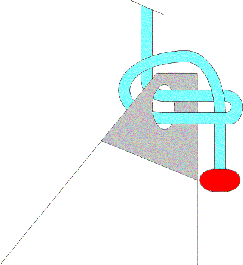 ..
..
This
solution allows the sail to be hoisted against the sheave, is strong and
cheap, and best of all, is easy to untie. This knot can of course also
be used to fix the outhaul to the clew of the sail but with the latest
Proctor booms a small block is shackled to the clew instead, creating an
extra purchase for the outhaul.
.
.
Jib
sheet
Two possible
sheet arrangements are possible: continuous sheeting or two separate ends.
Which one is used depends largely on the preference of the skipper.
Two
separate ends
In fact,
this is a single sheet tied to the jib in the middle, thus creating two
ends. Of course we never use pin shackles
or carbine hooks to attach the sheet to the jib or genoa. Apart from the
damage that the metal work can do to the boat, it is a real health hazard,
especially if the sail flogs.
..
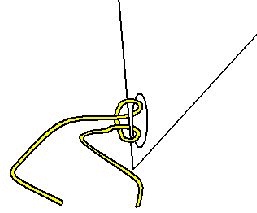 ..
..
The
traditional way of attaching the sheet to the jib is the cow hitch. The
cow hitch (above) is not a nice hitch if we want to be able to change
sails quickly. The sheet has to be completely removed from the fairleads,
etc. Again we need to find a simple and reliable way to attach the sheet
to the sail, yet allow easy removal.
The "ideal
knot" described above for the mainsail canít be used directly. But with
the small adaptation shown below, the sheet can be attached to, and removed
from the jib just as easily.
..
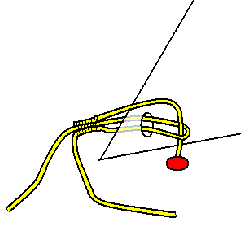 ..
..
A loop
is made at the mid-point of the jib sheet by using some whipping twine.
Then a short helper line is also securely attached with whipping twine.
At the end of the helper line, a plastic stopper is attached. Again, it
is important to use a stopper that cannot slip through the clew cringle.
Continuous
sheeting
A continuous
sheet is threaded through both jib fairleads and each of its ends is then
tied to the clew cringle of the jib. Many racers prefer a continuous sheet
since it becomes impossible to lose the sheet end to the low, lee side
of the boat where it often canít be retrieved without losing speed or risking
a capsize. A disadvantage is that the sheet always runs across the cockpit
and it needs two knots to fix it to the Jib or Genoa. That increases the
chances that the knot will get stuck under some part of the boat or mast.
The
trick with the plastic ball canít be used, for it would require the sheet
to pass through the cringle four times. Unless a very thin sheet is used,
that isnít an option. So, we shall have to use more traditional knots.
The following knots can be considered:
-
The Bowline
The most common way to tie the sheet to the jib is the bowline, Though
the bowline is very reliable, it easily gets stuck under boat parts. That
chance is increased because two of bowlines are needed...
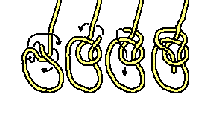 ..
..
-
The Fisherman's
knot It is better to use a Fishermanís knot (below) through the sail.
.The chances
of the knots getting stuck somewhere are minimal since the two overhand
knots are right up against the sail. However, the knots can be pulled
through the clew cringle, when a thin sheet is used.
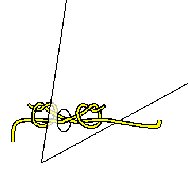 ..
..
-
The double
Fishermanís knot (below) won't pull through the clew cringle
as easily but is harder to untie.
..
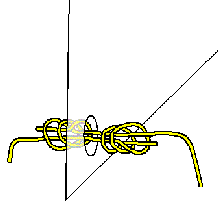 ..
..
-
A Fishermanís
knot using a two figure eight knots as shown below may be the best
solution. The knots are relatively easy to untie yet they are bulky enough
to avoid slipping through the cringle...
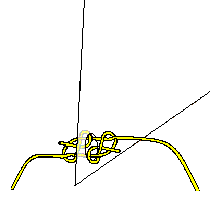 ..
..
It is
hard to decide which of the above is the best solution. It all depends
on how the sheet is led through the boat, the thickness of the sheet, the
diameter of the cringle, and - last but not least - the preference of the
skipper. I hope that, from the ideas above, you will have no trouble choosing
the best solution for yourself and your boat.
Ton
Jaspers (W5011) |






